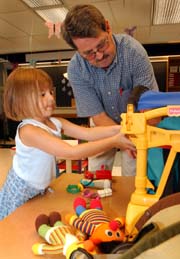Babbling key to evaluating speech development in babies with hearing loss

David Ertmer, a Purdue University speech-language pathologist, plays with 4-year-old Emily Jones from Monon, Ind., to provide language stimulation. Emily has had a cochlear implant for 30 months. Ertmer, who specializes in early speech and language development in children with hearing losses, created www.VocalDevelopment.com, an interactive Web site for parents, students and professionals. The site can help parents by providing audio examples of baby jargon, such as squealing and babbling, so they can recognize when their child has made progress in early speech development. (Purdue News Service photo/David Umberger) <br>
Parents of deaf toddlers with cochlear implants or hearing aids have a new Internet tool to help them monitor their babies’ progress in early speech development thanks to a Purdue University speech-language pathologist.
David Ertmer, who specializes in early speech and language development in children with hearing losses, created www.VocalDevelopment.com, an interactive Web site for parents, students and professionals. The site provides parents with audio examples of baby jargon, such as squealing and babbling, so they can recognize when their child has made progress in early speech development. The site also provides information on how to help infants and toddlers develop listening and speech skills.
“This site provides information about the initial stages of speech development in young children with normal and impaired hearing,” said Ertmer, an associate professor in audiology and speech sciences in the School of Liberal Arts. “Infant sounds are difficult to categorize because they fail to conform to adult speech patterns. At the site, we provide audio examples and practice identifying vocalizations so that parents and clinicians can recognize when the child begins to produce more mature speech patterns.”
The implementation of universal newborn hearing screening has led to earlier identification of hearing impairments. As a result, within the first two years of life more babies and toddlers are receiving hearing aids or cochlear implants, which are surgically implanted electronic devices that process sound and directly stimulate the auditory nerve.
“More than 40 states now implement universal infant hearing screenings, so the number of infants and toddlers who need assistance learning to speak with hearing aids or cochlear implants is growing substantially,” Ertmer said. “Progress in vocal development is one of the first signs of benefit from these devices.”
Ertmer says most parents, and even some professionals, are not equipped to know what sounds a child should be making as they learn to talk with a hearing aid or cochlear implant.
“Without firsthand listening experience, the identification of speech problems in very young children may be delayed simply because professionals are unable to recognize the hallmarks of vocal development,” he said. “Parents and caregivers also can use the information at this site to monitor how a child is learning to use their cochlear implants or hearing aids.”
At this Web site, parents and professionals learn how to classify vocalizations, such as babbling and jargon, according to three developmental levels: precanonical, canonical and postcanonical. During the precanonical stage, which is from birth to 6 months in infants with normal hearing, the child produces mainly grunt-like and vowel-like sounds. Between 6 months and 10 months, the child begins to combine vowels and consonants to form adultlike syllables. These vocalizations, called canonical syllables or babbling, are an important hallmark of early speech development. Between 8 months and 10 months, children typically begin to produce the complex and speechlike vocalizations found in the postcanonical level.
Advancement in vocal development, along with observations of appropriate responses to environmental sounds and speech, provide early indications that the child is receiving benefit from a hearing aid or a cochlear implant.
The site, which was created in 2001, also provides a self-check for users to assess their classification skills for variety of vocalizations. Feedback is provided after 10 responses. In addition, a research-based intervention program for toddlers with hearing loss, “Short Period of Prelinguistic Input,” also is described. This program provides suggestions to stimulate vocal development and increase the number of vowels and consonants that the child says. Language stimulation techniques also are discussed, and video clips of parents using these techniques with children during daily activities are available.
Ertmer said the Web site also will benefit colleagues and students in the field of communication disorders because infant vocalization recordings can now be included in undergraduate or graduate classroom instruction.
VocalDevelopment.com was programmed by Jason Galster, currently a doctoral student in audiology at Vanderbilt University, and funded through a grant from Purdue’s Multimedia Instructional Development Center.
Writer: Amy Patterson-Neubert, (765) 494-9723, apatterson@purdue.edu
Source: David Ertmer (765) 496-2249, dertmer@purdue.edu
Media Contact
All latest news from the category: Health and Medicine
This subject area encompasses research and studies in the field of human medicine.
Among the wide-ranging list of topics covered here are anesthesiology, anatomy, surgery, human genetics, hygiene and environmental medicine, internal medicine, neurology, pharmacology, physiology, urology and dental medicine.
Newest articles
Humans vs Machines—Who’s Better at Recognizing Speech?
Are humans or machines better at recognizing speech? A new study shows that in noisy conditions, current automatic speech recognition (ASR) systems achieve remarkable accuracy and sometimes even surpass human…

Not Lost in Translation: AI Increases Sign Language Recognition Accuracy
Additional data can help differentiate subtle gestures, hand positions, facial expressions The Complexity of Sign Languages Sign languages have been developed by nations around the world to fit the local…

Breaking the Ice: Glacier Melting Alters Arctic Fjord Ecosystems
The regions of the Arctic are particularly vulnerable to climate change. However, there is a lack of comprehensive scientific information about the environmental changes there. Researchers from the Helmholtz Center…


